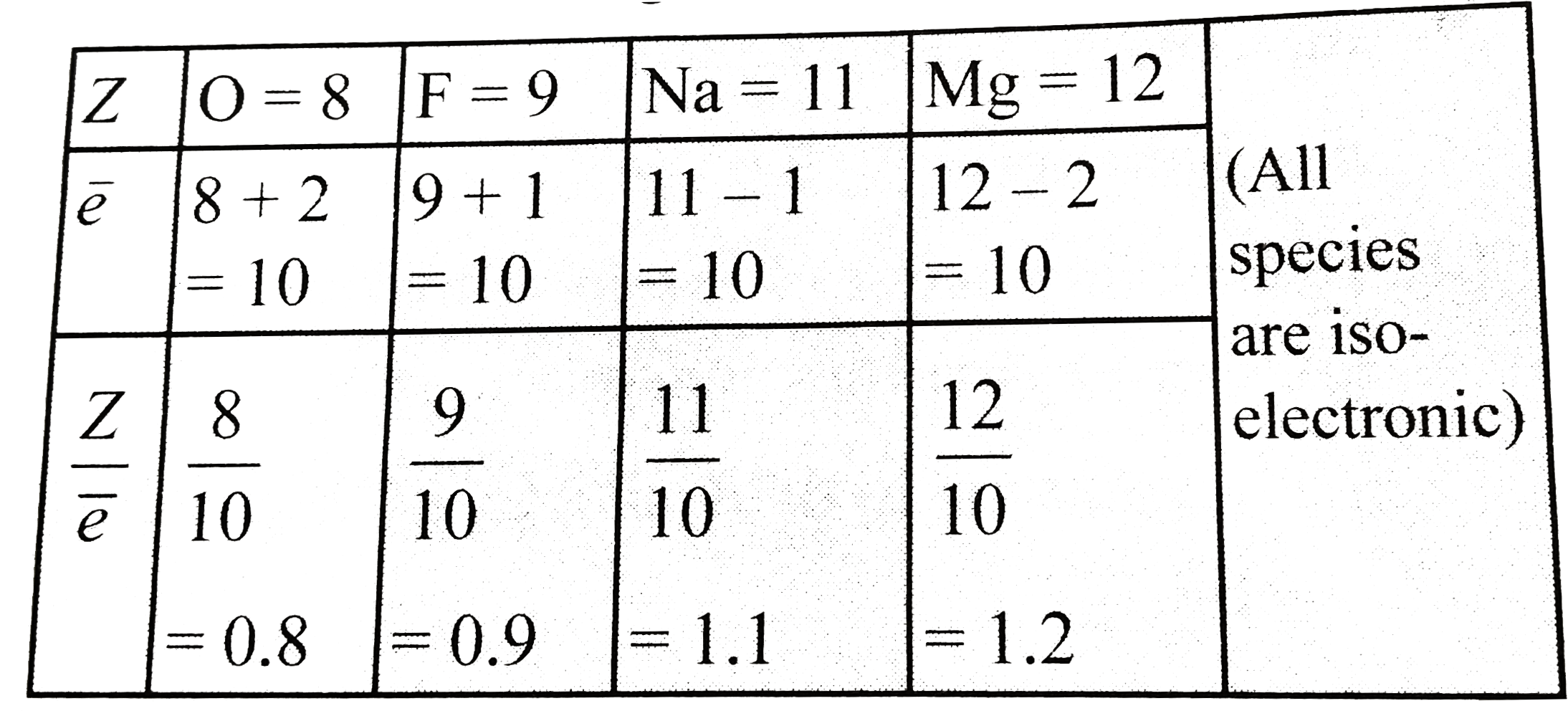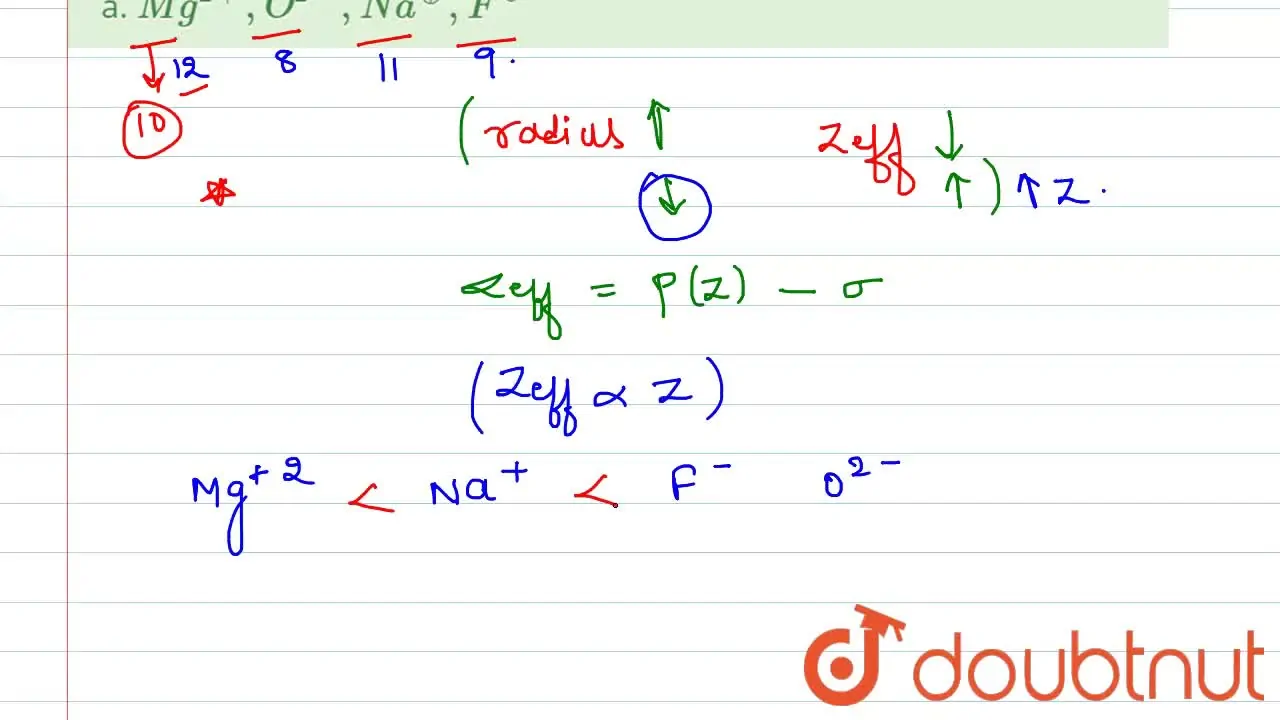Arrange the order of decreasing/increasing properties given below:
1. Decreasing order of atomic and ionic radii
a. Mg2+,O2−,Na⊕,Fɵ
a. O−2>F>Na⊕>Mg2+

Smaller the value of Z¯e, larger is the size.
Hence the order is as given above.
b.  , (All species areisoelectronic)
, (All species areisoelectronic)
i. Size of element decreases along the same period (→) (due to greater electron-electron repulsion).
ii. Size of Ca (4th period) gt size of Ar (3rd period), but the size of Ar gt size of Ca+. Therefore, Size of dinegative ion gt size of mononegative ion gt noble gas (of the same period) gt size of dipositive cation.
hence the order is as given above.
c. N3−>O2−>F>Na⊕>Mg2+ (All species are isoelectronic)
∣∣∣ZN=7O=8F=9Na=11Mg=12e−7+3=108+2=109+1=1011−1=1012−2=10∣∣∣
Same explanation as in parts (a) and (b) above
d. Se4th Period>S3rd Period>C2nd Period>O2nd Period
size of atom increases down the group because of addtion of new shell (or increase in principal quantum number n).
Size of atm decreases along the period (→), i.e. decreases from C to O.
e. Ni>3rd PeriodLi>2nd PeriodBe>B2nd Period
Same explanation as in part (d) above.
f. Li⊕>Na⊕>K⊕>Rb⊕>Cs⊕ (in aqueous solution)
The ions in solution are present as hydrate ions. The smaller the size of the ion, greater is the charge density and hence greater is the extent of hydration. So, the size of hydrated ions becomes larger for the smaller sized ion and vice versa.
g. Na⊕>Mg2+>Si4+>Cl7+ (All species are isoelectronic)
∣∣∣ZNa=11Mg=12Si=14Cl=17¯e11−1=1012−2=1014−4=1017−7=10∣∣∣
Smaller the charge on the cation, larger is the size and vice versa.
h. Hɵ>Li>H⊕ (The species are not isoelectronic)
∣∣
∣
∣∣ZH=1Li=3H=1¯e1+1=23+0=31−1=0Ze12=0.538=1.0−∣∣
∣
∣∣
Smaller the value of Ze−, larger is the size.
i. O2−>Fɵ>Li⊕>B3+ (All species are not isoelectronic but all of them belong to the same 2nd period)
∣∣∣ZO=8F=9Li=3B=5¯e8+2=109+1=103−1=25−3=2∣∣∣
Higher the −ve charge, larger is the size and higher the +v charge, smaller is the size of an ion j.
 , [All the species are not-isoelectronic]
, [All the species are not-isoelectronic]
∣∣∣ZI=53I=53I=53Br=35e−53+1=5453+0=5353−1=5235+1=36∣∣∣
Same explanation as in (a) and (b) above.
k. Iɵ>I>I⊕ [Same explanation as in (j)]
I. K⊕>Ca2+>Ti3+>Ti4+ [Same explanation as in (g)]
m. (ZforCe=58,Sn=60,Yb=70andLu=71)
∣∣∣Group12−131415161718ElementNaMgAlSiPSClAr∣∣∣
In lanthanides, the size decreases from La to Lu(Z=57to71) due to lanthanide contration. Although Sn belongs to the 5th period but its size is larger than lanthanides.
n. O2−>Fɵ>O>F
(The species are not isoelectronic)
[Same explanationas in parts (a) and (b) above]
o. Br>Ar>Ca2+>Mg2+
Related Playlists
- BOOK - CENGAGE CHEMISTRY ENGLISHCHAPTER - PERIODIC CLASSIFICATION OF ELEMENTS AND GENERAL INORGANIC CHEMISTRYEXERCISE - Solved Examples34videos
PERIODIC CLASSIFICATION OF ELEMENTS AND GENERAL INORGANIC CHEMISTRY
- BOOK - CENGAGE CHEMISTRY ENGLISHCHAPTER - PERIODIC CLASSIFICATION OF ELEMENTS AND GENERAL INORGANIC CHEMISTRYEXERCISE - Ex 1.114videos
PERIODIC CLASSIFICATION OF ELEMENTS AND GENERAL INORGANIC CHEMISTRY
- BOOK - CENGAGE CHEMISTRY ENGLISHCHAPTER - P-BLOCK GROUP 14 - CARBON FAMILYEXERCISE - Exercises Archives (Subjective)9videos
P-BLOCK GROUP 14 - CARBON FAMILY
- BOOK - CENGAGE CHEMISTRY ENGLISHCHAPTER - PURIFICATION OF ORGANIC COMPOUNDS AND QUALITATIVE AND QUANTITATIVE ANALYSISEXERCISE - Assertion Reasoning Type5videos
PURIFICATION OF ORGANIC COMPOUNDS AND QUALITATIVE AND QUANTITATIVE ANALYSIS
Similar Questions
Arrange pH of the given compounds in decreasing order :
View SolutionAmong O,C,F,Cl and Br the increasing order of atomic radii is
View SolutionArrange the following according to the given trend.
Na, Al, Mg, P (Increasing order of atomic size)View SolutionArrange the as per he instruction given in the bracket:
Br,F,Cl [decreasing order of atomic radius]View SolutionArrange the following according to the given trend.
F, CI, O, N, S (Increasing order of atomic size)View SolutionIncreasing order of ionic size :
N3−,Na+,F−,O2−,Mg2+View SolutionArrange in decreasing order as directed.
(a) Decreasing order of EN:C,O,N,FView SolutionArrange the element as per the guidelines in brackets.
Na, Cl, Mg, P [in decreasing order of atomic size]View SolutionArrange the elements as per the instructions:
Mg, CI, Na, S, Si [decreasing order of atomic size].View SolutionArrange the following in increasing order of their atomic radius: Na, K, Mg, Rb
View Solution


